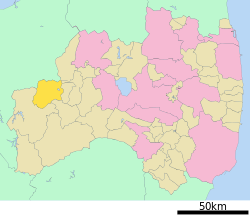Kaneyama, Fukushima
| Kaneyama 金山町 | |||
|---|---|---|---|
| Town | |||
|
Kaneyama Town Hall | |||
| |||
 Location of Kaneyama in Fukushima Prefecture | |||
 Kaneyama | |||
| Coordinates: 37°27′13.3″N 139°32′28.7″E / 37.453694°N 139.541306°ECoordinates: 37°27′13.3″N 139°32′28.7″E / 37.453694°N 139.541306°E | |||
| Country | Japan | ||
| Region | Tōhoku | ||
| Prefecture | Fukushima Prefecture | ||
| District | Ōnuma District | ||
| Area | |||
| • Total | 293.97 km2 (113.50 sq mi) | ||
| Population (September 2014) | |||
| • Total | 2,185 | ||
| • Density | 7.43/km2 (19.2/sq mi) | ||
| Time zone | UTC+9 (Japan Standard Time) | ||
| - Tree | Paulownia tomentosa | ||
| - Flower | Magnolia kobus | ||
| - Bird | Common cuckoo | ||
| Phone number | 0241-45-2211 | ||
| Address | 393 Yachi Kawaguchi Kaneyama-machi, Ōnuma-gun, Fukushima-ken 968-0011 | ||
| Website | http://www.town.kaneyama.fukushima.jp/ | ||
Kaneyama (金山町 Kaneyama-machi) is a town located in Fukushima Prefecture, Japan. As of September 2014, the town had an estimated population of 2,185, and a population density of 7.43 persons per km². The total area is 293.97 km². Kaneyama is noted for its spectacular scenery.
Geography
Kaneyama is located in mountainous northwest of the Aizu region of Fukushima Prefecture, bordered Niigata Prefecture to the west. The climate is like many other parts of northern Japan, with cold winters and snowfall averaging 2 meters. Kaneyama has no town center, but is an artificial construct made up of a number of small villages scattered alongside the Tadami River. Kaneyama has many hot springs.
- Mountains : Mount Mikagura (1386.5 m), Mount Takamori
- Rivers : Tadami River
- Lakes: Lake Numazawa
Neighboring municipalities
History
The area of present-day Kaneyama was part of ancient Mutsu Province and formed part of the holdings of Aizu Domain during the Edo period. After the Meiji Restoration, it was organized as part of Ōnuma District.
Modern Kaneyama village was founded on July 1, 1955 through a merger of the villages of Yokota, Kawaguchi, Numzawa and Honna. It was raised to town status in 1958.
One of the villages in the town, Mifuke, on the banks of the Tadami River, was struck by a landslide in April 1964, was abandoned, and now is a ghost town only visited occasionally by tourists and former residents. The displaced people were integrated into the village of Amenuma across the river.[1][2]
Economy
Hydroelectric power generation from numerous dams on the Tadami River is the primary source of revenue for the village
Education
- Fukushima Prefectural Kawaguchi High School
Transportation
Railway
- JR East – Tadami Line
- Aizu-Mizunuma - Aizu-Nakagawa - Aizu-Kawaguchi - (Closed due to line damage) - Honna - Aizu-Kosugawa - Aizu-Yokota - Aizu-Ōshio
Highway
References
- ↑ "Mugenkyo no Watashi". Okuaizu. Archived from the original on 16 September 2018.
- ↑ "Foggy Fukushima river tour draws influx of visitors". The Japan Times. Fukushima Minpo. 16 September 2018. Archived from the original on 16 September 2018.
External links
![]()
- Official Website (in Japanese)
